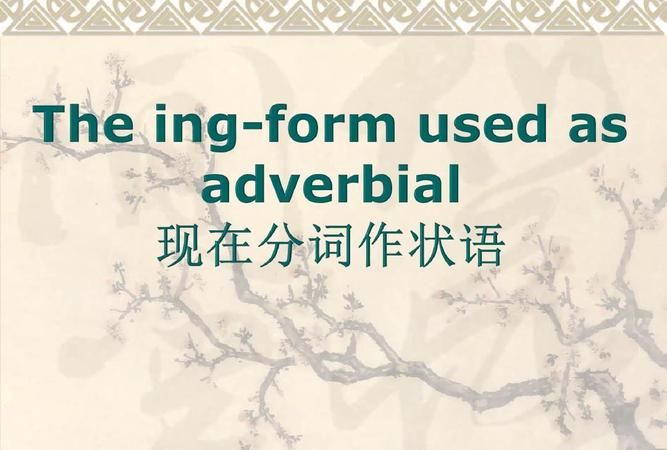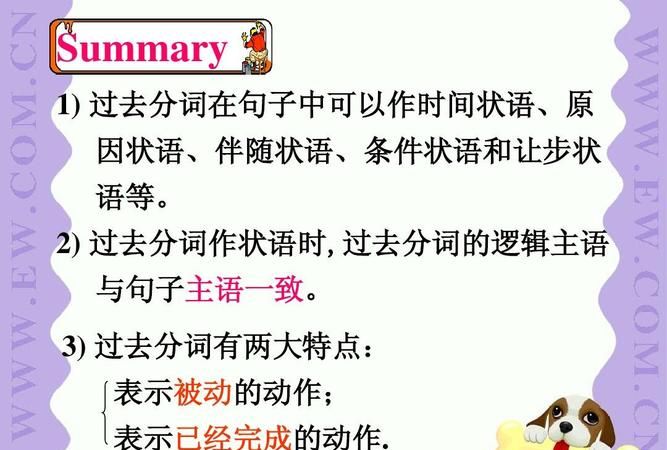本文目录
过去分词短语在句中作状语例句
1.过去分词作状语过去分词作状语表示被动的和完成的动作.
2.过去分词作状语时其逻辑主语为主句的主语,此时应注意人称一致.
3.过去分词作状语来源于状语从句.
4.过去分词作状语的位置.过去分词可放在主句前作句首状语,后面有逗号与主句隔开;也可放在主句后面,前面有逗号与主句隔开.

过去分词短语作状语

初中分词作状语的用法讲解归纳总结
很多同学都不太了解分词作状语的用法,我整理了一些分词的知识点,大家一起来看看吧。
过去分词作状语用法归纳
一、过去分词(短语)作状语时,其逻辑主语通常就是句子的主语。过去分词(短语)作状语一般都用逗号同其它成分隔开。
1. 作时间状语时,可转换为when或while等引导的从句,通常放在句首。如:
Seen from the top of the hill (= When it is seen from the top of the hill), the school looks like a big garden.
2. 作条件状语时,可转换为once, if或unless等引导的从句,一般放在句首。如:
Given more attention (= If it was given more attention), the fire could have been avoided.
3. 作原因状语时,可转换为because, as或since等引导的从句,多放在句首。如:
Encouraged (= As she was encouraged) by the teacher, the girl was very happy.
4. 作让步状语时,可转换为though, although 或even if引导的从句,常放在句首。如:
Left (= Although she was left) alone at home, Jenny didn’t feel afraid at all.
5. 作方式或伴随状语时,常可转换为并列分句,可位于句首或句末。如:
Surrounded by his students, the teacher went into the lab. (= The teacher was surrounded by his students and he went into the lab.)
6. 过去分词(短语)作状语时,有时为了强调,前面可带连词when, while, if, though, as if, unless等。如:
When given a physical examination, you should keep calm.
二、现在分词与过去分词作状语的区别
现在分词作状语与过去分词作状语的最主要区别就在于两者与所修饰的主语在逻辑上是主动还是被动关系。
1. 现在分词作状语时,现在分词表示的动作与主语之间在逻辑上是主动关系。如:
Not knowing what to do, he asked his good friend for help.
2. 过去分词作状语时,主语是过去分词动作的承受者,它们之间是被动关系。如:
Given more attention, the flowers could have grown better.
常见分词作状语的情况举例
表条件:Given more time, I would be able to complete the work. United we stand; divided we fall. (合则兴,分则亡)
表时间:Walking in the street,I saw him.
表原因:Getting hurt badly in the match, he has to stay at home.
表伴随:Watching the TV play, she burst out crying.
表让步:Having lived in China for years, he still can’t speak Chinese well.
表结果:I went home, finding the door locked.
表方式:Smiling, he answered.
表比较:Compared with the desktop, the laptop is easier to carry. Compared with elephant, ant looks much smaller.
典型例题
1)_____ some officials, napoleon inspected his army.
a. followed b. followed by c. being followed d. having been followed
答案b. napoleon 与follow 之间有被动的含义。being followed除表达被动之外,还有动作正在进行之意。 followed by(被…跟随)。本题可改为:with some officials following, napoleon inspected his army.
2)_______, liquids can be changed into gases.
a. heating b. to be heated c. heated d. heat
答案c. 本题要选一分词作为状语。现在分词表主动,正在进行的;过去分词表被动的,已经完成的。对于液体来说是加热的受动者,是被动的,因而选c。它相当于一个状语从句 when it is heated,…
3)there was a terrible noise ___ the sudden burst of light.
a. followed b. following c. to be followed d. being followed
答案b. 由于声音在闪电后,因此为声跟随着光,声音为跟随的发出者,为主动。用现在分词。
注意: 选择现在分词还是过去分词,关键看主句的主语。如分词的动作是主句的主语发出,分词就选用现在分词,反之就用过去分词。
(being ) used for a long time, the book looks old.
由于用了很长时间,这本书看上去很旧。
using the book, i find it useful.
以上就是一些分词作状语的相关信息,供大家参考。

现在过去分词做状语
回答:英语过去分词作状语可以表示时间、原因、条件、方式、伴随、让步等,相当于原因、时间、条件、让步状语从句,或相当于并列谓语。过去分词作状语表示时间、条件、让步时,还可以把表示时间、条件、让步的连词置于其前,以示强调。过去分词在句中作状语时通常置于句首和句尾。它置于句首要用逗号与主句隔开;它置于句尾时,若过去分词短语较长则可用逗号;若较短,则可以不用逗号。过去分词只有一种形式,它可以表示完成的动作或状态、被动关系,或与主句的动作同时发生。过去分词的否定是在其前加not。例如:
( As he was )Injured in the leg, he couldn't go traveling.
( When he was ) Questioned by the police, he remained silent.
( If I am ) Not given two days, I cannot finish the task.
( Though he was ) scolded by the teacher, he still didn't correct his mistake.
He entered the office, ( and was ) followed by Tom.
He stood there ( and was ) filled with terror.

以上就是关于过去分词作状语赛课课件 ,过去分词短语在句中作状语例句的全部内容,以及过去分词作状语赛课课件 的相关内容,希望能够帮到您。
